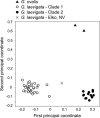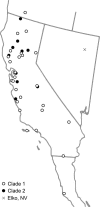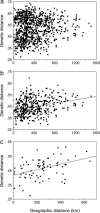Cryptic species within the cosmopolitan desiccation-tolerant moss Grimmia laevigata
- PMID: 16407098
- PMCID: PMC1334683
- DOI: 10.1073/pnas.0510267103
Cryptic species within the cosmopolitan desiccation-tolerant moss Grimmia laevigata
Abstract
The common cushion moss Grimmia laevigata (Bridel) Bridel grows on bare rock in a broad range of environments on every continent except Antarctica. As such, it must harbor adaptations to a remarkably broad set of environmental stresses, the extremes of which can include very high temperatures, prolonged nearly complete desiccation, and high ultraviolet B (UVB) exposure. Yet, like many mosses, G. laevigata shows very little morphological variability across its cosmopolitan range. This presents an evolutionary puzzle, the solution to which lies in understanding the phylogeographic structure of this morphologically simple organism. Here we report the results of an analysis of amplified fragment length polymorphisms (AFLPs) in G. laevigata, focusing on individuals from the California Floristic Province. We found evidence that populations within California constitute two distinct geographically overlapping cryptic species. Each clade harbors multiple private alleles, indicating they have been genetically isolated for some time. We suggest that the existence of cryptic species within G. laevigata, in combination with its life history, growth habits, and extreme desiccation tolerance, makes this moss an ideal research tool and a candidate for a biological indicator of climate change and pollution.
Figures




Similar articles
-
Molecular phylogeography of the moss Tortula muralis Hedw (Pottiaceae) based on chloroplast rps4 gene sequence data.Plant Biol (Stuttg). 2004 Mar-Apr;6(2):147-57. doi: 10.1055/s-2004-817801. Plant Biol (Stuttg). 2004. PMID: 15045665
-
Species delimitation and cryptic diversity in the moss genus Scleropodium (Brachytheciaceae).Mol Phylogenet Evol. 2012 Jun;63(3):891-903. doi: 10.1016/j.ympev.2012.03.002. Epub 2012 Mar 13. Mol Phylogenet Evol. 2012. PMID: 22421213
-
Identification of genic moss SSR markers and a comparative analysis of twenty-four algal and plant gene indices reveal species-specific rather than group-specific characteristics of microsatellites.BMC Plant Biol. 2006 May 30;6:9. doi: 10.1186/1471-2229-6-9. BMC Plant Biol. 2006. PMID: 16734891 Free PMC article.
-
Molecular tools to study Physcomitrella patens.Plant Biol (Stuttg). 2005 May;7(3):220-7. doi: 10.1055/s-2005-865645. Plant Biol (Stuttg). 2005. PMID: 15912441 Review.
-
[The moss Physcomitrella patens, a new model system for functional genomics].Yi Chuan. 2004 Jul;26(4):560-6. Yi Chuan. 2004. PMID: 15640062 Review. Chinese.
Cited by
-
Empirical evidence supporting frequent cryptic speciation in epiphyllous liverworts: a case study of the Cololejeunea lanciloba complex.PLoS One. 2013 Dec 18;8(12):e84124. doi: 10.1371/journal.pone.0084124. eCollection 2013. PLoS One. 2013. PMID: 24367634 Free PMC article.
-
Clonal diversity and geographic structure in Pleurochaete squarrosa (Pottiaceae): different sampling scale approach.J Plant Res. 2009 Mar;122(2):161-70. doi: 10.1007/s10265-008-0206-4. Epub 2009 Jan 8. J Plant Res. 2009. PMID: 19129968
-
GpDSR7, a Novel E3 Ubiquitin Ligase Gene in Grimmia pilifera Is Involved in Tolerance to Drought Stress in Arabidopsis.PLoS One. 2016 May 26;11(5):e0155455. doi: 10.1371/journal.pone.0155455. eCollection 2016. PLoS One. 2016. PMID: 27228205 Free PMC article.
-
Integrative taxonomy resolves the cryptic and pseudo-cryptic Radula buccinifera complex (Porellales, Jungermanniopsida), including two reinstated and five new species.PhytoKeys. 2013 Oct 30;(27):1-113. doi: 10.3897/phytokeys.27.5523. eCollection 2013. PhytoKeys. 2013. PMID: 24223490 Free PMC article.
-
Morphological, genetic and ecological divergence in near-cryptic bryophyte species widespread in the Holarctic: the Dicranum acutifolium complex (Dicranales) revisited in the Alps.J Plant Res. 2024 Jul;137(4):561-574. doi: 10.1007/s10265-024-01534-3. Epub 2024 Mar 23. J Plant Res. 2024. PMID: 38520483 Free PMC article.
References
-
- Pócs, T. (1982) in Bryophyte Ecology, ed. Smith, A. J. E. (Chapman & Hall, London), pp. 59–104.
-
- Shevock, J. R. (2003) Fremontia 31, 12–20.
-
- Longton, R. E. (1988) The Biology of Polar Bryophytes and Lichens (Cambridge Univ. Press, Cambridge, U.K.).
-
- Proctor, M. C. F. & Pence, V. C. (2002) in Desiccation and Survival in Plants: Drying without Dying, eds. Black, M. & Pritchard, H. W. (CABI, Wallingford, U.K.), pp. 207–237.
-
- Liu, Y., Cao, T. & Glime, J. M. (2003) Bryologist 106, 53–60.
Publication types
MeSH terms
Substances
LinkOut - more resources
Full Text Sources
Medical
Research Materials

